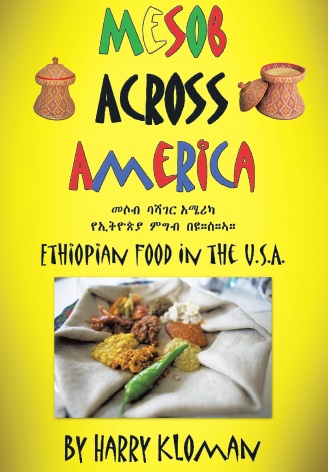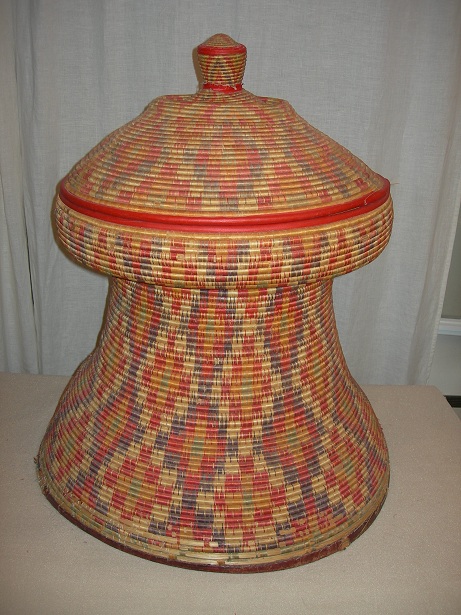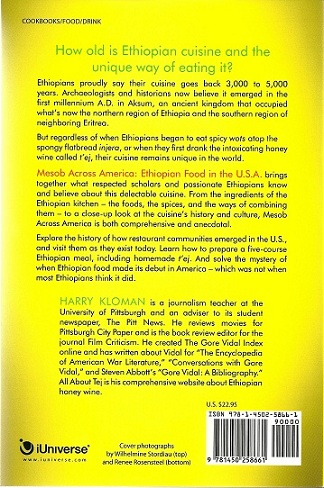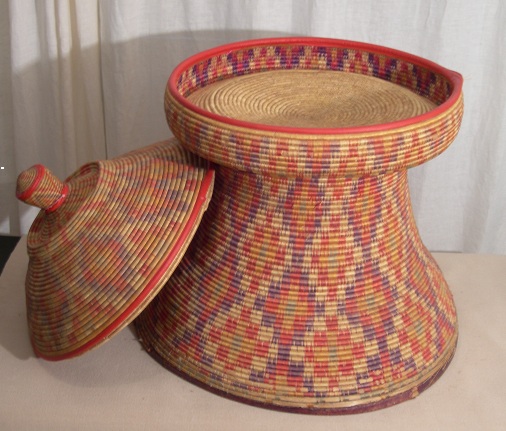

 |
|
(Click to enlarge) |
This comprehensive book explores all aspects of Ethiopian cuisine in America: its history and culture, the food itself, selected recipes and preparations, restaurants and restaurant owners, and a complementary website that features a guide to Ethiopian restaurants and markets in the United States.
Drawing upon the research of top scholars, as well as the experiences and memories of myriad Ethiopian-Americans, Mesob Across America explores the cuisine of Ethiopia and the community of cuisine that has formed in America during the past half century.
Here's what you'll find in the book's chapters:
 The Ethiopian Meal.
A close look at how Ethiopian people eat and why they eat this way, the
essential terms and basic elements of the meal, the ingredients of
Ethiopian cuisine, the three daily meals, fasting holidays of the
country's three major religions, and finally, "The Enigma of Ethiopian
Cooking" - what makes one cook's food different than another's. > > Read More > >
The Ethiopian Meal.
A close look at how Ethiopian people eat and why they eat this way, the
essential terms and basic elements of the meal, the ingredients of
Ethiopian cuisine, the three daily meals, fasting holidays of the
country's three major religions, and finally, "The Enigma of Ethiopian
Cooking" - what makes one cook's food different than another's. > > Read More > >

 Learn where you can
buy the
book
Learn where you can
buy the
book A Stroll Through
Ethiopian
History. This ancient nation's history in abbreviated form,
introducing terms, ideas and elements that will recur and that are
relevant to food. >
Read More > >
A Stroll Through
Ethiopian
History. This ancient nation's history in abbreviated form,
introducing terms, ideas and elements that will recur and that are
relevant to food. >
Read More > >
 The History of Ethiopian
Food. The cuisine of Ethiopia began to develop in Aksum, the
ancient nation from which Ethiopia emerged. What do archaeologists know
about what Aksumites ate and when they ate it? And what happened after
Aksum? Trace how the cuisine of modern Ethiopia emerged. > > Read More > >
The History of Ethiopian
Food. The cuisine of Ethiopia began to develop in Aksum, the
ancient nation from which Ethiopia emerged. What do archaeologists know
about what Aksumites ate and when they ate it? And what happened after
Aksum? Trace how the cuisine of modern Ethiopia emerged. > > Read More > >
 Acquiring a Taste: Europe's
First Encounters with Ethiopian Food. Drawing from historic
accounts, this chapter focuses on what European visitors said about the
cuisine, from the 1400s to the early 20th Century. > > Read More > >
Acquiring a Taste: Europe's
First Encounters with Ethiopian Food. Drawing from historic
accounts, this chapter focuses on what European visitors said about the
cuisine, from the 1400s to the early 20th Century. > > Read More > >
 Learn where you can
buy the
book
Learn where you can
buy the
book What To Eat, Where To
Eat. What do Ethiopians in America eat, and what do
restaurants serve? How does restaurant food here compare to the food back
home? With the growth of the cuisine in America, several Ethio-American
entrepreneurs have now started to import beer and wine from Ethiopia, and
nearly a dozen wineries make Ethiopian honey wine in America. > > Read More > >
What To Eat, Where To
Eat. What do Ethiopians in America eat, and what do
restaurants serve? How does restaurant food here compare to the food back
home? With the growth of the cuisine in America, several Ethio-American
entrepreneurs have now started to import beer and wine from Ethiopia, and
nearly a dozen wineries make Ethiopian honey wine in America. > > Read More > >
 |
|
(Click to enlarge) |
 Injera & Teff. The
smallest grain in the world, teff is native only to Ethiopia, and it's
used to make injera, the Ethiopian bread. Now numerous farms and
companies grow teff in America to meet the burgeoning demand for it. In
big cities, Ethiopian women make injera in their homes and sell
it to markets, restaurants and individuals. And an Ethiopian engineer has
invented an innovative machine that makes injera by automation.
> > Read More > >
Injera & Teff. The
smallest grain in the world, teff is native only to Ethiopia, and it's
used to make injera, the Ethiopian bread. Now numerous farms and
companies grow teff in America to meet the burgeoning demand for it. In
big cities, Ethiopian women make injera in their homes and sell
it to markets, restaurants and individuals. And an Ethiopian engineer has
invented an innovative machine that makes injera by automation.
> > Read More > >
 Ethiopia & Coffee.
Ethiopia introduced coffee to the world in the ninth century, and the
plant grows native in its temperate highlands. In Ethiopia, people conduct
a ceremony to serve and drink coffee, which is an important export crop,
although world market prices often exploit the small, poor, rural people
who harvest it. > >
Read More > >
Ethiopia & Coffee.
Ethiopia introduced coffee to the world in the ninth century, and the
plant grows native in its temperate highlands. In Ethiopia, people conduct
a ceremony to serve and drink coffee, which is an important export crop,
although world market prices often exploit the small, poor, rural people
who harvest it. > >
Read More > >
 T'ej: The Ancient Honey
Wine. Ethiopians have made t'ej for 2,000 years.
Learn how to make it at home, where you can buy t'ej made by
wineries, and where you can buy the supplies you need to make your own. > > Read More > >
T'ej: The Ancient Honey
Wine. Ethiopians have made t'ej for 2,000 years.
Learn how to make it at home, where you can buy t'ej made by
wineries, and where you can buy the supplies you need to make your own. > > Read More > >
 Visit All About Tej: The
Ethiopian Honey Wine
Visit All About Tej: The
Ethiopian Honey Wine 
 The First Supper & The Spices of
Life. Where was the first Ethiopian in the United States? It
wasn't in Washington, D.C., as many people think. And who pioneered the
production and sale of Ethiopian spices in America? Read about these two
early culinary enterprises. > > Read More > >
The First Supper & The Spices of
Life. Where was the first Ethiopian in the United States? It
wasn't in Washington, D.C., as many people think. And who pioneered the
production and sale of Ethiopian spices in America? Read about these two
early culinary enterprises. > > Read More > >

 Communities of Cuisine,
Part 1:
Addis Ababa in America. Washington, D.C., and its Maryland
and Virginia suburbs have the largest population of Ethiopians outside of
Ethiopia. Trace the history of this community's emergence and see what it
looks like today. >
> Read More > >
Communities of Cuisine,
Part 1:
Addis Ababa in America. Washington, D.C., and its Maryland
and Virginia suburbs have the largest population of Ethiopians outside of
Ethiopia. Trace the history of this community's emergence and see what it
looks like today. >
> Read More > >
 Communities of Cuisine,
Part 2:
Urban Life. Some of America's largest cities have substantial
Ethiopian populations. Read about the communities and restaurants of
Chicago, San Francisco and the bay area, Los Angeles, and the surprisingly
small community of New York City, which doesn't even have an Ethiopian
grocery store. > >
Read More > >
Communities of Cuisine,
Part 2:
Urban Life. Some of America's largest cities have substantial
Ethiopian populations. Read about the communities and restaurants of
Chicago, San Francisco and the bay area, Los Angeles, and the surprisingly
small community of New York City, which doesn't even have an Ethiopian
grocery store. > >
Read More > >
 Communities of Cuisine,
Part 3: Village Life. Here are profiles of Ethiopians and
restaurants from cities and states with small or no communities: Alaska,
Columbus, Pittsburgh, Michigan, Wisconsin, Iowa, Cincinnati, Indianapolis,
North Carolina, Idaho, Utah, South Dakota, New England and Philadelphia.
> > Read More >
>
Communities of Cuisine,
Part 3: Village Life. Here are profiles of Ethiopians and
restaurants from cities and states with small or no communities: Alaska,
Columbus, Pittsburgh, Michigan, Wisconsin, Iowa, Cincinnati, Indianapolis,
North Carolina, Idaho, Utah, South Dakota, New England and Philadelphia.
> > Read More >
>
 Learn where you can
buy the
book
Learn where you can
buy the
book Preparing an Ethiopian
Feast. Learn how to cook a six-dish Ethiopian meal from
scratch, including homemade t'ej. There's a shopping list,
detailed day-by-day and hour-by-hour preparations, and a look at Ethiopian
cookbooks that you can buy to further your culinary adventure. > > Read More > >
Preparing an Ethiopian
Feast. Learn how to cook a six-dish Ethiopian meal from
scratch, including homemade t'ej. There's a shopping list,
detailed day-by-day and hour-by-hour preparations, and a look at Ethiopian
cookbooks that you can buy to further your culinary adventure. > > Read More > >
 An Epilogue: Ferenj
Tales. Read about the Mighty Mitad and the Pepper Eater,
devices invented by design teams in a graduate program at Stanford
University that creates products to help poor people in underdeveloped
countries. These teams worked on projects for Ethiopia, and both projects
relate to food. Then, meet Carl and Pat Templin, an American couple who
lived in the south of Ethiopia from 1964-1975, and who share their
memories of Ethiopian food over there and back home in America. > > Read More > >
An Epilogue: Ferenj
Tales. Read about the Mighty Mitad and the Pepper Eater,
devices invented by design teams in a graduate program at Stanford
University that creates products to help poor people in underdeveloped
countries. These teams worked on projects for Ethiopia, and both projects
relate to food. Then, meet Carl and Pat Templin, an American couple who
lived in the south of Ethiopia from 1964-1975, and who share their
memories of Ethiopian food over there and back home in America. > > Read More > >

 Finding an Ethiopian Restaurant. There are around 330
Ethiopian and Eritrean restaurants in the country - fewer than the number
of Chinese restaurants in New York City alone. More than half of these
restaurants have websites, and thanks to people who have posted videos on
the internet, you can "visit" around 50 of them. The book version of
Mesob Across America doesn't include a list of restaurants
because the business can change so quickly. But this website offers a comprehensive list, along with video visits, and I welcome
corrections and additions. > > Read More > >
Finding an Ethiopian Restaurant. There are around 330
Ethiopian and Eritrean restaurants in the country - fewer than the number
of Chinese restaurants in New York City alone. More than half of these
restaurants have websites, and thanks to people who have posted videos on
the internet, you can "visit" around 50 of them. The book version of
Mesob Across America doesn't include a list of restaurants
because the business can change so quickly. But this website offers a comprehensive list, along with video visits, and I welcome
corrections and additions. > > Read More > >
 Finding an Ethiopian
Market. If you'd like to prepare the Ethiopian feast at home, or
if you just want to make t'ej, you'll need to buy some unique
Ethiopian spices and injera to make your meal authentic. This
website offers a guide to Ethiopian markets
that will help you shop online or in person. > > Read More > >
Finding an Ethiopian
Market. If you'd like to prepare the Ethiopian feast at home, or
if you just want to make t'ej, you'll need to buy some unique
Ethiopian spices and injera to make your meal authentic. This
website offers a guide to Ethiopian markets
that will help you shop online or in person. > > Read More > >
 Finally, in a series of appendices at the end
of the book, you can find out what Ethiopian restaurant names mean and see
the recipes for the feast in traditioinal form. There's also a
bibliography of sources cited in the book. > > Read More > >
Finally, in a series of appendices at the end
of the book, you can find out what Ethiopian restaurant names mean and see
the recipes for the feast in traditioinal form. There's also a
bibliography of sources cited in the book. > > Read More > >
Harry Kloman
University of Pittsburgh
�Copyright 2010 by Harry Kloman